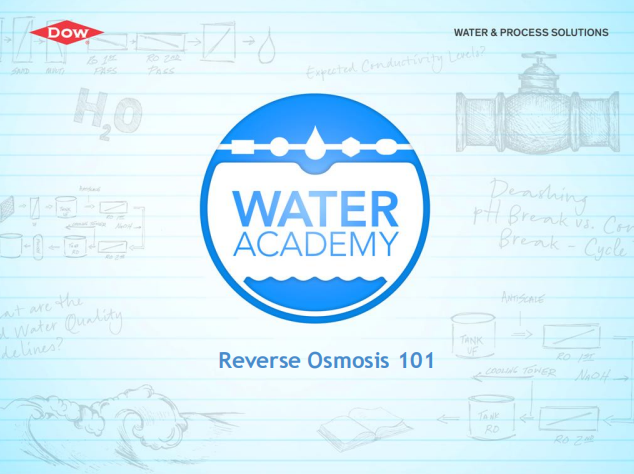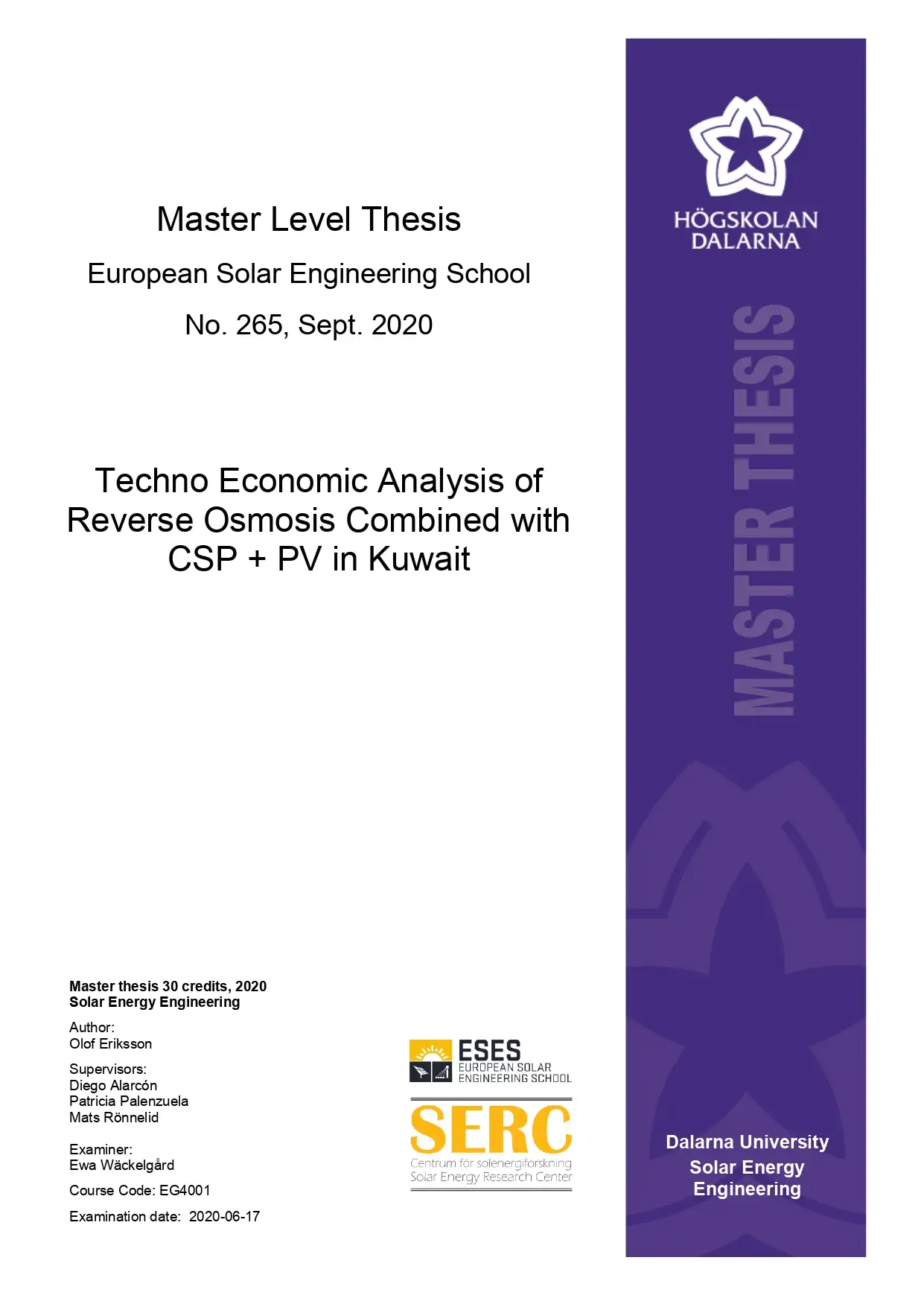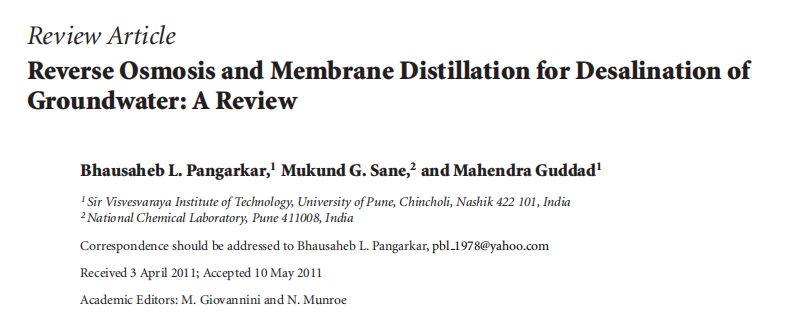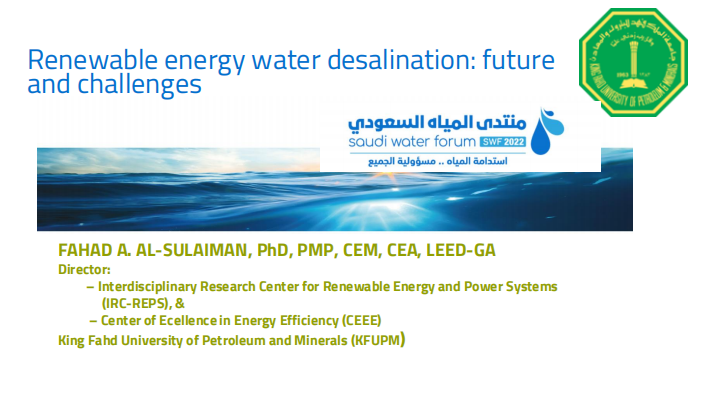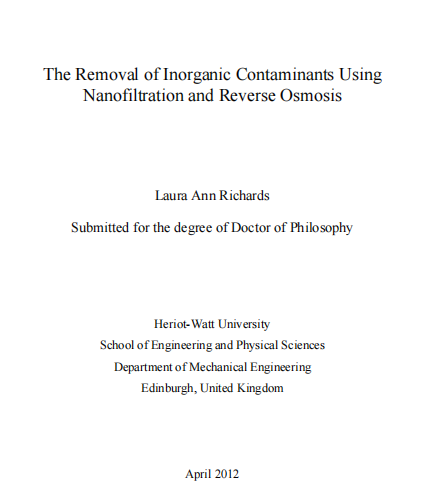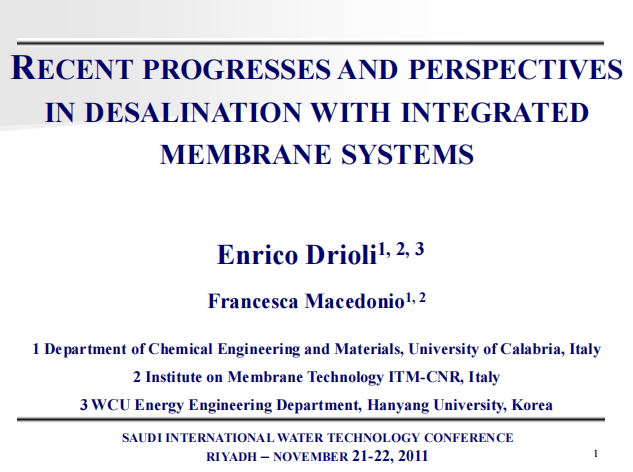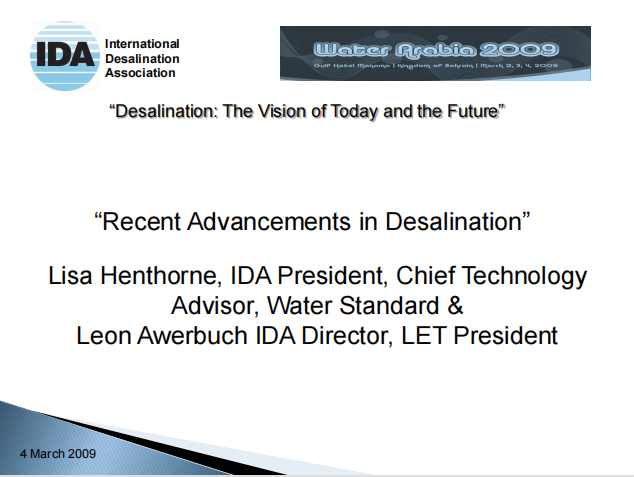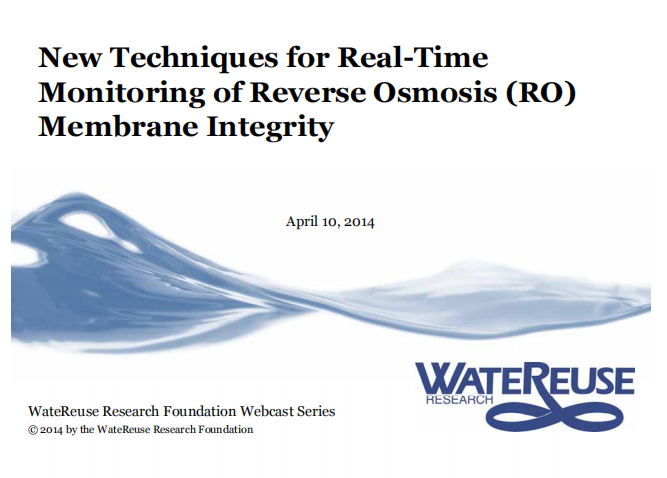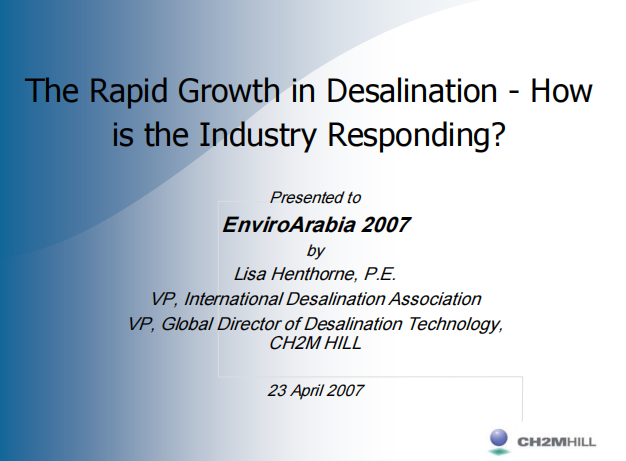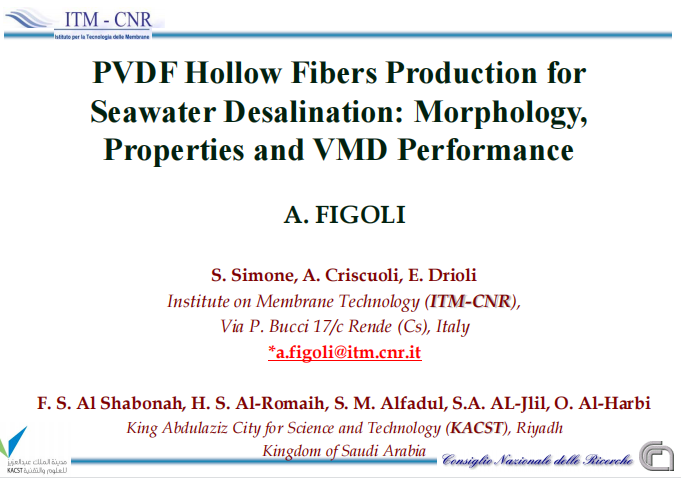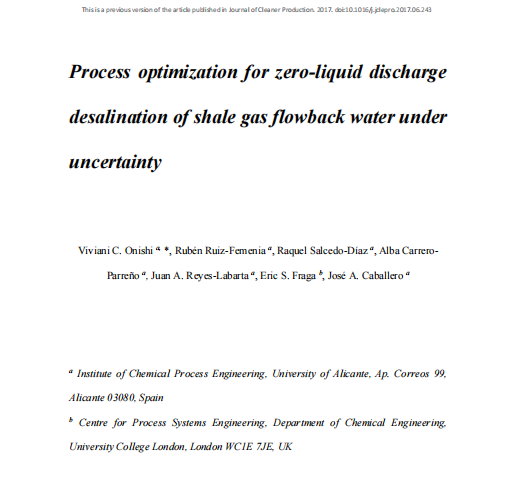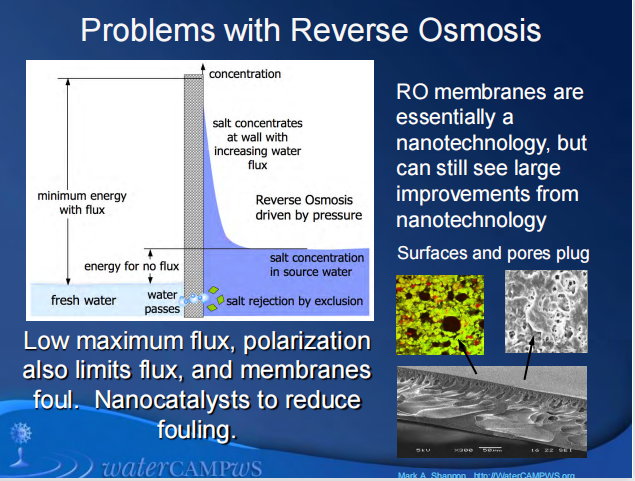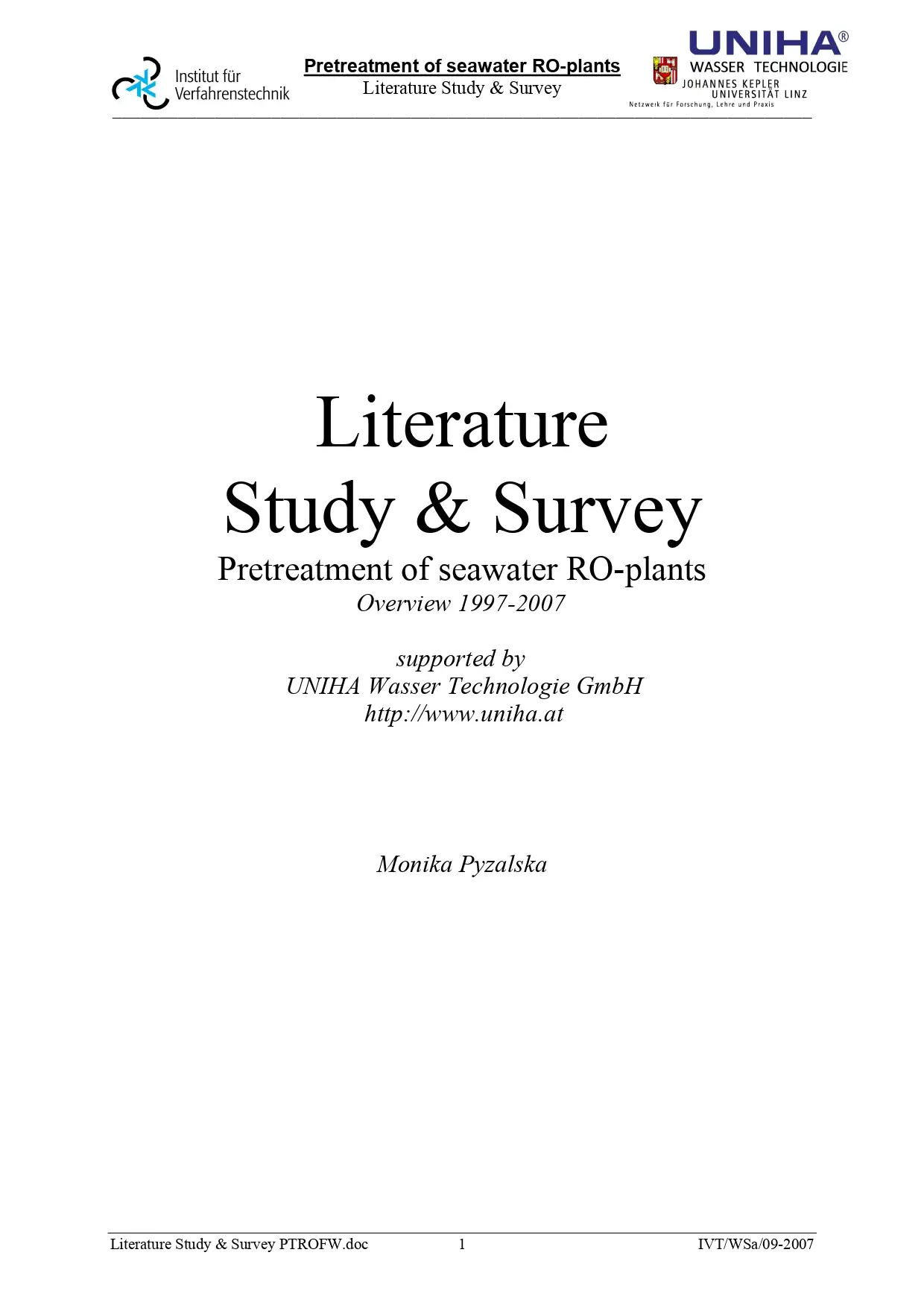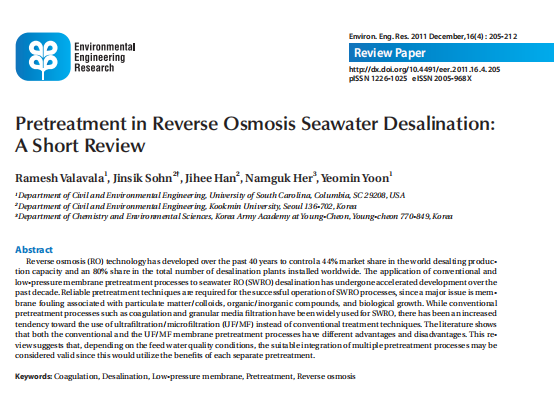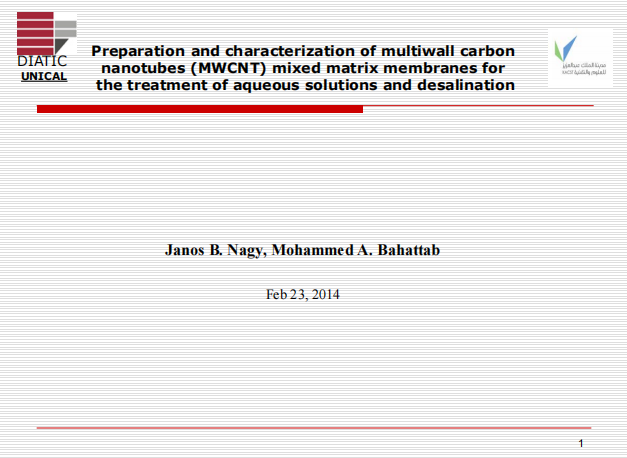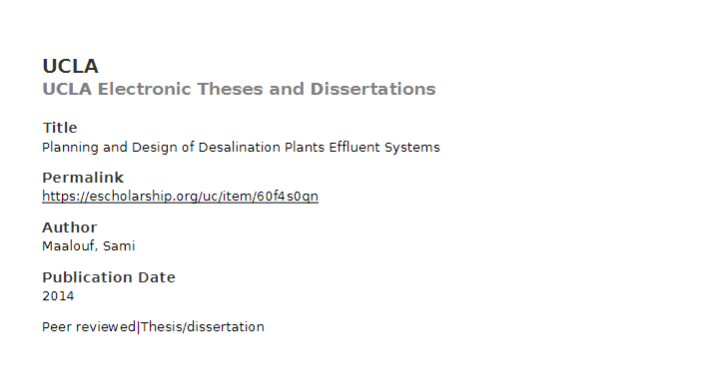Techno Economic Analysis Of Reverse Osmosis Combined With CSP + PV In Kuwait
Abstract:
Seawater desalination plays an important role when fighting the freshwater scarcity that many places around the world are currently facing. The increasing need for desalinated water is followed by a high energy demand. It is therefore essential that an expansion of desalination capacity is accompanied by a parallel use of renewable energy sources in this process. This thesis presents a techno-economic study on a reverse osmosis (RO) desalination plant, with a nominal power consumption of 15 MW, that is powered by a concentrated solar power (CSP) plant combined with a photovoltaic (PV) power plant, in Kuwait. The main aim of this thesis was to find which system designs would give the lowest global warming potential and levelized cost of the desalinated water. In addition, it has been investigated how electricity price and emission allowance cost could make a solar power plant competitive to the grid. For this purpose, some components in the whole system were simulated using System Advisor Model and Engineering Equation Solver. With the results obtained from the simulations, a dynamic model of the whole system was developed in MATLAB, Simulink where simulations were done for a typical meteorological year in Shagaya, Kuwait. Both on-grid and off-grid systems were considered.
Techno Economic Analysis Of Reverse Osmosis Combined With CSP + PV In Kuwait
Abstract:
Seawater desalination plays an important role when fighting the freshwater scarcity that many places around the world are currently facing. The increasing need for desalinated water is followed by a high energy demand. It is therefore essential that an expansion of desalination capacity is accompanied by a parallel use of renewable energy sources in this process. This thesis presents a techno-economic study on a reverse osmosis (RO) desalination plant, with a nominal power consumption of 15 MW, that is powered by a concentrated solar power (CSP) plant combined with a photovoltaic (PV) power plant, in Kuwait. The main aim of this thesis was to find which system designs would give the lowest global warming potential and levelized cost of the desalinated water. In addition, it has been investigated how electricity price and emission allowance cost could make a solar power plant competitive to the grid. For this purpose, some components in the whole system were simulated using System Advisor Model and Engineering Equation Solver. With the results obtained from the simulations, a dynamic model of the whole system was developed in MATLAB, Simulink where simulations were done for a typical meteorological year in Shagaya, Kuwait. Both on-grid and off-grid systems were considered.
Reverse Osmosis And Membrane Distillation For Desalination Of Groundwater: A Review
Introduction:
Water is the source of life, the basis of human survival, and the principal material base to guarantee the economy substantial development of a country. With increasing global population, the gap between the supply and demand for water is widening and is reaching such alarming levels that in some part of the world, it is posing a threat to human existence [1]. The fresh water scarcity is a growing problem all over the world because only 1% of earth’s water is fresh water available for human to drink [2]. The US geological survey found that 96.5% of earth’s water is located in seas and oceans and 1.7% of earth’s water is located in the ice caps. The remaining percentage is made up of brackish water,
slightly salty water found as surface water in estuaries and as groundwater in salty aquifers [3]. The need for fresh water is at the top of the international agenda of critical problems, at least as firmly as climate change. India as a country has 16% of the world’s population and 4% of its fresh water resources[4]. Due to rapid industrialization and development, there is an increased opportunity for grey water reuse in developing countries such as India. Although India occupies only 3.29 million km2 geographical area, which forms 2.4% of the world’s land area, it supports over 15% of world’s population. The population of India as of March 31, 2011 was 1,210,193,422 persons (Census, 2011). India also has a livestock population of 500 million, which is about 20% of world’s total livestock. However total annual utilizable water resources of the country are 1086 km3 which is only 4% of world’s water resources [5]. Total annual utilizable resources of surface water and groundwater are 690 km3 and 396 km3, respectively [6]. Consequent to rapid growth in population and increasing water demand, stress on water resources in India is increasing and per capita water availability is reducing day by day. In India, per capita surface water availability in the years 1991 and 2001 were 2300 m3 (6.3 m3/day) and 1980 m3 (5.7 m3/day), respectively, and these are projected to reduce to 1401 and 1191 m3 by the years 2025 and 2050, respectively [5].
Reverse Osmosis And Membrane Distillation For Desalination Of Groundwater: A Review
Introduction:
Water is the source of life, the basis of human survival, and the principal material base to guarantee the economy substantial development of a country. With increasing global population, the gap between the supply and demand for water is widening and is reaching such alarming levels that in some part of the world, it is posing a threat to human existence [1]. The fresh water scarcity is a growing problem all over the world because only 1% of earth’s water is fresh water available for human to drink [2]. The US geological survey found that 96.5% of earth’s water is located in seas and oceans and 1.7% of earth’s water is located in the ice caps. The remaining percentage is made up of brackish water,
slightly salty water found as surface water in estuaries and as groundwater in salty aquifers [3]. The need for fresh water is at the top of the international agenda of critical problems, at least as firmly as climate change. India as a country has 16% of the world’s population and 4% of its fresh water resources[4]. Due to rapid industrialization and development, there is an increased opportunity for grey water reuse in developing countries such as India. Although India occupies only 3.29 million km2 geographical area, which forms 2.4% of the world’s land area, it supports over 15% of world’s population. The population of India as of March 31, 2011 was 1,210,193,422 persons (Census, 2011). India also has a livestock population of 500 million, which is about 20% of world’s total livestock. However total annual utilizable water resources of the country are 1086 km3 which is only 4% of world’s water resources [5]. Total annual utilizable resources of surface water and groundwater are 690 km3 and 396 km3, respectively [6]. Consequent to rapid growth in population and increasing water demand, stress on water resources in India is increasing and per capita water availability is reducing day by day. In India, per capita surface water availability in the years 1991 and 2001 were 2300 m3 (6.3 m3/day) and 1980 m3 (5.7 m3/day), respectively, and these are projected to reduce to 1401 and 1191 m3 by the years 2025 and 2050, respectively [5].
The Removal Of Inorganic Contaminants Using Nanofiltration And Reverse Osmosis
Abstract:
Improved methods of providing safe drinking water are essential in an era in which demand for water is increasing but surface water supplies remain scarce. Desalination of brackish groundwater via membrane filtration with nanofiltration and reverse osmosis (NF/RO) offers a solution to this problem. As such, the overall motivation of this study was to improve mechanistic understanding of NF/RO. The first main aim was to evaluate the performance of a renewable energy membrane system previously tested with real groundwater and varying energy conditions. Given sufficient solar availability, the system reliably removed salts and inorganic contaminants, although solute retention varied with energy (and consequently pressure and flow) and pH, depending on dominant retention mechanisms. The second main aim was to assess the specific impact of pH on inorganic contaminant removal in a bench-scale filtration system. The speciation of boron, fluoride and nitrate was linked with ion retention as a function of pH, with results suggesting that there may be important mechanisms such as ion dehydration controlling transport in NF/RO, which would explain the high retention of fluoride when compared to nitrate. The third main aim was to determine the importance of ion hydration in determining transport using molecular dynamics simulations of monovalent anions transporting through an idealized pore. Simulations demonstrated that energy barriers of transport were strongly dependent on ion properties and pore size and were directly attributable to dehydration. The final aim was to experimentally verify molecular dynamics simulations by quantifying energy barriers for ion transport in NF membranes. Experimentally-determined energy barriers were also solute and membrane-specific, with fluoride having a higher barrier than other solutes. Comparison of results with expected dehydration trends and molecular dynamics corroborated that energy barriers in nanofiltration may be due to dehydration. The results obtained in this thesis provide new insight into NF/RO transport mechanisms, which may contribute to improvements in current technologies and predictive models.
The Removal Of Inorganic Contaminants Using Nanofiltration And Reverse Osmosis
Abstract:
Improved methods of providing safe drinking water are essential in an era in which demand for water is increasing but surface water supplies remain scarce. Desalination of brackish groundwater via membrane filtration with nanofiltration and reverse osmosis (NF/RO) offers a solution to this problem. As such, the overall motivation of this study was to improve mechanistic understanding of NF/RO. The first main aim was to evaluate the performance of a renewable energy membrane system previously tested with real groundwater and varying energy conditions. Given sufficient solar availability, the system reliably removed salts and inorganic contaminants, although solute retention varied with energy (and consequently pressure and flow) and pH, depending on dominant retention mechanisms. The second main aim was to assess the specific impact of pH on inorganic contaminant removal in a bench-scale filtration system. The speciation of boron, fluoride and nitrate was linked with ion retention as a function of pH, with results suggesting that there may be important mechanisms such as ion dehydration controlling transport in NF/RO, which would explain the high retention of fluoride when compared to nitrate. The third main aim was to determine the importance of ion hydration in determining transport using molecular dynamics simulations of monovalent anions transporting through an idealized pore. Simulations demonstrated that energy barriers of transport were strongly dependent on ion properties and pore size and were directly attributable to dehydration. The final aim was to experimentally verify molecular dynamics simulations by quantifying energy barriers for ion transport in NF membranes. Experimentally-determined energy barriers were also solute and membrane-specific, with fluoride having a higher barrier than other solutes. Comparison of results with expected dehydration trends and molecular dynamics corroborated that energy barriers in nanofiltration may be due to dehydration. The results obtained in this thesis provide new insight into NF/RO transport mechanisms, which may contribute to improvements in current technologies and predictive models.
Process Optimization For Zero-Liquid Discharge Desalination Of Shale Gas Flowback Water Under Uncertainty
Abstract
Sustainable and efficient desalination is required to treat the large amounts of high salinity flowback water from shale gas extraction. Nevertheless, uncertainty associated with well data (including water flowrates and salinities) strongly hampers the process design task. In this work, we introduce a new optimization model for the synthesis of zero-liquid discharge (ZLD) desalination systems under uncertainty. The desalination system is based on multiple-effect evaporation with mechanical vapor recompression (MEE-MVR). Our main objective is energy efficiency intensification through brine discharge reduction, while accounting for distinct water feeding scenarios. For this purpose, we consider the outflow brine salinity near to salt saturation condition as a design constraint to achieve ZLD operation. In this innovative approach, uncertain parameters are mathematically modelled as a set of correlated scenarios with known probability of occurrence. The scenarios set is described by a multivariate normal distribution generated via a sampling technique with symmetric correlation matrix. The stochastic multi scenario non-linear programming (NLP) model is implemented in GAMS, and optimized by the minimization of the expected total annualized cost. An illustrative case study is carried out to evaluate the capabilities of the proposed new approach. Cumulative probability
curves are constructed to assess the financial risk related to uncertain space for different standard deviations of expected mean values. Sensitivity analysis is performed to appraise optimal system performance for distinct brine salinity conditions. This methodology represents a useful tool to support decision-makers towards the selection of more robust and reliable ZLD desalination systems for the treatment of shale gas flowback water.
Process Optimization For Zero-Liquid Discharge Desalination Of Shale Gas Flowback Water Under Uncertainty
Abstract
Sustainable and efficient desalination is required to treat the large amounts of high salinity flowback water from shale gas extraction. Nevertheless, uncertainty associated with well data (including water flowrates and salinities) strongly hampers the process design task. In this work, we introduce a new optimization model for the synthesis of zero-liquid discharge (ZLD) desalination systems under uncertainty. The desalination system is based on multiple-effect evaporation with mechanical vapor recompression (MEE-MVR). Our main objective is energy efficiency intensification through brine discharge reduction, while accounting for distinct water feeding scenarios. For this purpose, we consider the outflow brine salinity near to salt saturation condition as a design constraint to achieve ZLD operation. In this innovative approach, uncertain parameters are mathematically modelled as a set of correlated scenarios with known probability of occurrence. The scenarios set is described by a multivariate normal distribution generated via a sampling technique with symmetric correlation matrix. The stochastic multi scenario non-linear programming (NLP) model is implemented in GAMS, and optimized by the minimization of the expected total annualized cost. An illustrative case study is carried out to evaluate the capabilities of the proposed new approach. Cumulative probability
curves are constructed to assess the financial risk related to uncertain space for different standard deviations of expected mean values. Sensitivity analysis is performed to appraise optimal system performance for distinct brine salinity conditions. This methodology represents a useful tool to support decision-makers towards the selection of more robust and reliable ZLD desalination systems for the treatment of shale gas flowback water.
Pretreatment in Reverse Osmosis Seawater Desalination: A Short Review
Abstract
Reverse osmosis (RO) technology has developed over the past 40 years to control a 44% market share in the world desalting production capacity and an 80% share in the total number of desalination plants installed worldwide. The application of conventional and
low-pressure membrane pretreatment processes to seawater RO (SWRO) desalination has undergone accelerated development over the
past decade. Reliable pretreatment techniques are required for the successful operation of SWRO processes, since a major issue is membrane fouling associated with particulate matter/colloids, organic/inorganic compounds, and biological growth. While conventional
pretreatment processes such as coagulation and granular media filtration have been widely used for SWRO, there has been an increased
tendency toward the use of ultrafiltration/microfiltration (UF/MF) instead of conventional treatment techniques. The literature shows
that both the conventional and the UF/MF membrane pretreatment processes have different advantages and disadvantages. This review suggests that, depending on the feed water quality conditions, the suitable integration of multiple pretreatment processes may be
considered valid since this would utilize the benefits of each separate pretreatment.
Pretreatment in Reverse Osmosis Seawater Desalination: A Short Review
Abstract
Reverse osmosis (RO) technology has developed over the past 40 years to control a 44% market share in the world desalting production capacity and an 80% share in the total number of desalination plants installed worldwide. The application of conventional and
low-pressure membrane pretreatment processes to seawater RO (SWRO) desalination has undergone accelerated development over the
past decade. Reliable pretreatment techniques are required for the successful operation of SWRO processes, since a major issue is membrane fouling associated with particulate matter/colloids, organic/inorganic compounds, and biological growth. While conventional
pretreatment processes such as coagulation and granular media filtration have been widely used for SWRO, there has been an increased
tendency toward the use of ultrafiltration/microfiltration (UF/MF) instead of conventional treatment techniques. The literature shows
that both the conventional and the UF/MF membrane pretreatment processes have different advantages and disadvantages. This review suggests that, depending on the feed water quality conditions, the suitable integration of multiple pretreatment processes may be
considered valid since this would utilize the benefits of each separate pretreatment.
Planning And Design Of Desalination Plants Effluent Systems
Introduction:
As the world’s population has drastically grown throughout the 20th century and into the current decades, existing renewable water resources are jeopardized by the rising demand for potable water. This is especially true in regions whose climates are characterized as arid and semi-arid, such as California (Green, 2007) as well as other regions (e.g., Australia, the Mediterranean Basin, Persian Gulf Countries, etc.). In addition, with rapid expansion of industries and urban centers around the globe, compounded by more frequent droughts caused by climate change, freshwater has become increasingly scarce.
Planning And Design Of Desalination Plants Effluent Systems
Introduction:
As the world’s population has drastically grown throughout the 20th century and into the current decades, existing renewable water resources are jeopardized by the rising demand for potable water. This is especially true in regions whose climates are characterized as arid and semi-arid, such as California (Green, 2007) as well as other regions (e.g., Australia, the Mediterranean Basin, Persian Gulf Countries, etc.). In addition, with rapid expansion of industries and urban centers around the globe, compounded by more frequent droughts caused by climate change, freshwater has become increasingly scarce.



